Planting 15,000 trees around our villages in Madagascar
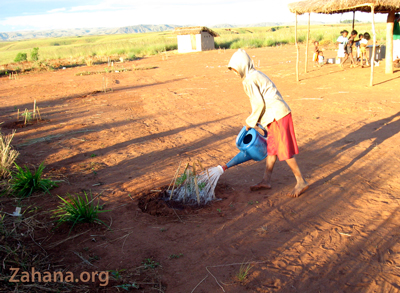
“My dream is to see both villages surrounded by forest and the mountain of Bevato covered with trees again, if we work with the villagers and support them to plant the 10 trees.” Dr. Ramihantaniarivo, MPH, Founder of Zahana
Zahana wants to plant 10 trees for each woman, child and man in our villages.
Based on community feedback we will actively involve the villagers as re-foresters and caretakers in this ambitious goal to plant some 15,000 trees over the next few years. Drawing on our gardeners’ years of experience growing seedlings and planting trees successfully, it is time to scale up our efforts and plant a forest.
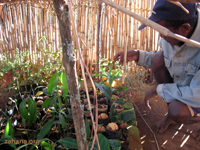
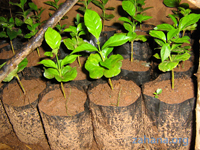 Zahana
has two experienced gardeners in
each village growing trees and
vegetable seedlings for the community at large (see our website.) In addition
each works with the students on their school
gardens. Both gardeners have
become our main innovators, testing new crops in their local climate. A
regular salary from Zahana gives them a secure income which allows them
more freedom to experiment and literally field test (agricultural) expert
advice first, before others come on board. With over 1000 coffee plants
and dozens of a variety of trees given away freely over the past years
and subsequently planted in schoolyards and villages, they have first hand
know-how in tree planting. Our tree
planting beginnings date back over 5 years to 2006.
Zahana
has two experienced gardeners in
each village growing trees and
vegetable seedlings for the community at large (see our website.) In addition
each works with the students on their school
gardens. Both gardeners have
become our main innovators, testing new crops in their local climate. A
regular salary from Zahana gives them a secure income which allows them
more freedom to experiment and literally field test (agricultural) expert
advice first, before others come on board. With over 1000 coffee plants
and dozens of a variety of trees given away freely over the past years
and subsequently planted in schoolyards and villages, they have first hand
know-how in tree planting. Our tree
planting beginnings date back over 5 years to 2006.
Our two
experienced gardeners will spearhead and supervise this community-wide
tree planting project. 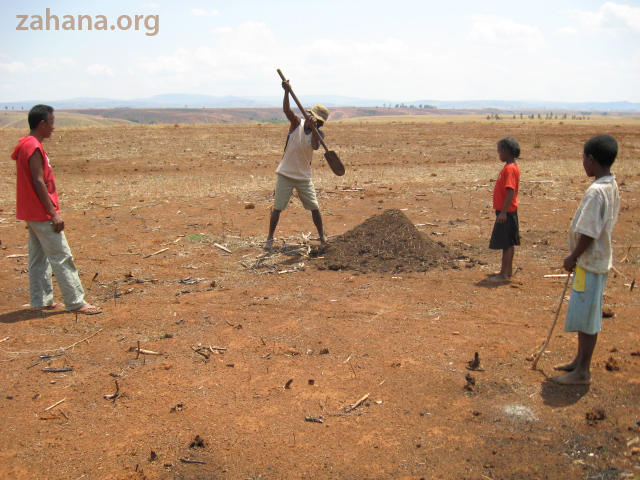 They grow the seedlings and train others to be
stewards, planting and tending to ‘their’ young trees, which
may need to be watered by hand until the root system is strong enough
to support it. For a tree to have optimal growing conditions a hole needs
to be dug that is at least one cubic meter (3x3x3 feet) and filled with
humus and organic matter, which is hard and time consuming work in a
country where everything is done by hand. This is hard work and Zahana
needs to pay for the food for people to digging the holes, to encourage
tree planting as a group activity and make up for the time they would
otherwise spend farming. As an incentive, there are prizes for the most
trees surviving after 1, 2 and 3 years to make sure this is seen as a
long term plan.
They grow the seedlings and train others to be
stewards, planting and tending to ‘their’ young trees, which
may need to be watered by hand until the root system is strong enough
to support it. For a tree to have optimal growing conditions a hole needs
to be dug that is at least one cubic meter (3x3x3 feet) and filled with
humus and organic matter, which is hard and time consuming work in a
country where everything is done by hand. This is hard work and Zahana
needs to pay for the food for people to digging the holes, to encourage
tree planting as a group activity and make up for the time they would
otherwise spend farming. As an incentive, there are prizes for the most
trees surviving after 1, 2 and 3 years to make sure this is seen as a
long term plan.
Starting
with fast growing tress with a reliable track record first, determined
by our gardeners, we are focusing initially on a human orchard that can
provide food and forest at the same time. 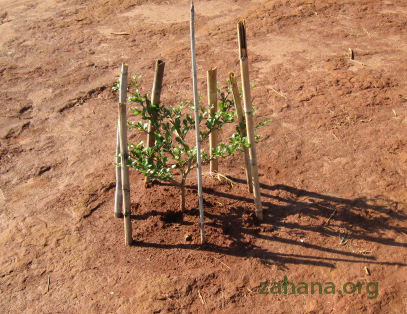 Initially we will start with
acacia, mantalis, moringa olifera, and mango trees. Fast growing trees,
such as moringa, provide the much-needed
groundcover and shade for other plants to take root. Moringa trees
have very fast growing wood which can be used as firewood as well, therefore
protecting the remaining natural tree flora from the ax of the firewood-seeking
villagers. Over the years these trees will be interspersed or replaced
by native trees.
Initially we will start with
acacia, mantalis, moringa olifera, and mango trees. Fast growing trees,
such as moringa, provide the much-needed
groundcover and shade for other plants to take root. Moringa trees
have very fast growing wood which can be used as firewood as well, therefore
protecting the remaining natural tree flora from the ax of the firewood-seeking
villagers. Over the years these trees will be interspersed or replaced
by native trees.
This project has to be seen in conjunction with our other activities. Improving cookstoves, another Zahana project, is equally important in reducing deforestation (see website.) Improving cookstoves alone does reduce the need for firewood drastically, but does not replace trees lost to cooking, where the reforestation project comes in. To combine both efforts, Zahana has decided that anybody interested in participating in the community-wide planting project, and the subsequent completion for the prizes, has to build and use an improved cookstove to solidify their commitment (an effort that takes less than an afternoon.)
To support our tree planting plans please visit our project at GlobalGiving










